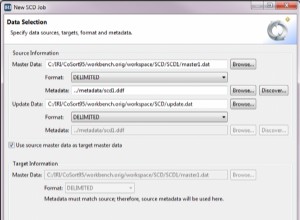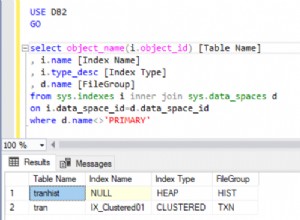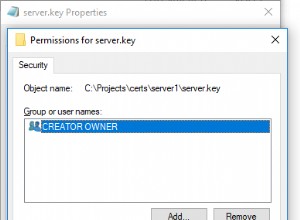एक काफी सरल दृष्टिकोण (और जो आस्कटॉम लिंक दिखाता है उसके समान) सभी वर्ष/महीने जोड़े, और सभी नाम/r_group जोड़े निकालने के लिए है, और फिर उनको क्रॉस-जॉइन करना है:
with data as (
select 1 id, 'A' name, 'fruit' r_group, '2007' year, '04' month, 5 sales from dual union all
select 2 id, 'Z' name, 'fruit' r_group, '2007' year, '04' month, 99 sales from dual union all
select 3 id, 'A' name, 'fruit' r_group, '2008' year, '05' month, 10 sales from dual union all
select 4 id, 'B' name, 'vegetable' r_group, '2008' year, '07' month, 20 sales from dual
)
select a.year, a.month, b.name, b.r_group, nvl(d.sales, 0) as sales
from (select distinct year, month from data) a
cross join (select distinct name, r_group from data) b
left join data d on d.year = a.year and d.month = a.month and d.name = b.name and d.r_group = b.r_group
order by year, month, name, r_group;
YEAR MO N R_GROUP SALES
---- -- - --------- ----------
2007 04 A fruit 5
2007 04 B vegetable 0
2007 04 Z fruit 99
2008 05 A fruit 10
2008 05 B vegetable 0
2008 05 Z fruit 0
2008 07 A fruit 0
2008 07 B vegetable 20
2008 07 Z fruit 0
लेकिन यह आपके पहले स्तर के एकत्रीकरण के साथ आपकी अपेक्षा से अधिक पंक्तियाँ उत्पन्न करता है:
YEAR MO N R_GROUP SALES OPENING CLOSING
---- -- - --------- ---------- ---------- ----------
2007 04 A fruit 5 0 5
2007 04 B vegetable 0 0 0
2007 04 Z fruit 99 0 99
2008 05 A fruit 10 5 15
2008 05 B vegetable 0 0 0
2008 05 Z fruit 0 99 99
2008 07 A fruit 0 15 15
2008 07 B vegetable 20 0 20
2008 07 Z fruit 0 99 99
और जब आपके दूसरे स्तर (दूसरी क्वेरी से) के साथ समेकित किया जाता है, तो 2007/04/सब्जी के लिए अतिरिक्त पंक्तियां उत्पन्न होंगी:
YEAR MO R_GROUP SALES OPENING CLOSING
---- -- --------- ---------- ---------- ----------
2007 04 fruit 104 0 104
2007 04 vegetable 0 0 0
2008 05 fruit 10 104 114
2008 05 vegetable 0 0 0
2008 07 fruit 0 114 114
2008 07 vegetable 20 0 20
जिन्हें आप एकत्र करने से पहले आंशिक रूप से फ़िल्टर कर सकते हैं क्योंकि सभी मध्यवर्ती कॉलम शून्य होंगे:
with data as (
select 1 id, 'A' name, 'fruit' r_group, '2007' year, '04' month, 5 sales from dual union all
select 2 id, 'Z' name, 'fruit' r_group, '2007' year, '04' month, 99 sales from dual union all
select 3 id, 'A' name, 'fruit' r_group, '2008' year, '05' month, 10 sales from dual union all
select 4 id, 'B' name, 'vegetable' r_group, '2008' year, '07' month, 20 sales from dual
)
select year,
month,
r_group,
sum(sales) sales,
sum(opening) opening,
sum(closing) closing
from (
select t.*,
(sum(sales) over (partition by name, r_group
order by year, month
rows between unbounded preceding and current row
) -sales ) as opening,
sum(sales) over (partition by name, r_group
order by year, month
rows between unbounded preceding and current row
) as closing
from (
select a.year, a.month, b.name, b.r_group, nvl(d.sales, 0) as sales
from (select distinct year, month from data) a
cross join (select distinct name, r_group from data) b
left join data d
on d.year = a.year and d.month = a.month and d.name = b.name and d.r_group = b.r_group
) t
)
where sales != 0 or opening != 0 or closing != 0
group by year, month, r_group
order by year, month;
पाने के लिए:
YEAR MO R_GROUP SALES OPENING CLOSING
---- -- --------- ---------- ---------- ----------
2007 04 fruit 104 0 104
2008 05 fruit 10 104 114
2008 07 fruit 0 114 114
2008 07 vegetable 20 0 20
आप उन पंक्तियों को निकालने के लिए उस परिणाम को और फ़िल्टर कर सकते हैं जहां कुल बिक्री मूल्य अभी भी शून्य है, हालांकि यदि आप फ़िल्टर पहले कर रहे हैं एकत्रीकरण की अब और आवश्यकता नहीं है; लेकिन यह अभी भी थोड़ा गन्दा है। और यह स्पष्ट नहीं है कि ऐसा करने के लिए आपके सबसे बाहरी एकत्रीकरण को संशोधित किया जा सकता है या नहीं।




